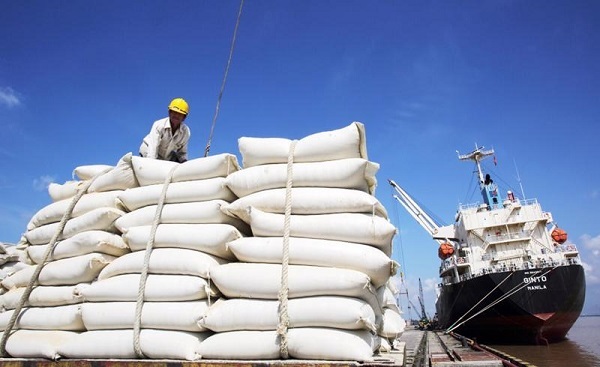The reason why food prices have risen is still not attractive to American farmers
American farmers are reluctant to increase production when food prices climb because costs are also increasing, weather is unpredictable and the workforce is also shrinking.
To learn about the development of modern American agriculture, you can visit the barn on Philip Volk’s ranch, near Rugby City in North Dakota. Inside the old building are equipment worth hundreds of thousands of dollars. A giant red combine harvester sits next to a green seeder, which looks a bit like a bread slicer. In addition, there is a tractor larger than a tank.
The sower is pulled by an automatic GPS moving machine. The mower cuts through the soil and takes just a week or so to sow the entire crop that, on Mr. Volk’s farm, mainly grows spring wheat.
Five to six months later, the combine harvester harvests it all almost as quickly. Trucks then take the wheat to sorting and load it onto trains bound for the west coast, mainly Japan.
With a team of four and a few other relatives and neighbors coming in at harvest time, Mr. Volk was able to cultivate 2,000 hectares of land. His great-grandfather was a German who immigrated to the United States, used to plow the land with horses, then manually sow seeds, with tens to hundreds of workers.
The first tractor, bought by grandfather Volk almost a century ago, is still in the warehouse. It is quite small compared to modern generations and is no longer used much on the farm. “I wouldn’t want to go back and sit on an open-cabin tractor and put up with my grandfather’s hard work,” Volk said.
American farmers are having an interesting time. On the North Dakota and Montana plains, the biggest season is spring wheat, which is planted in April and harvested in late summer. Cultivation on farms in Montana has begun, and Mr. Volk will be seeding as well.

Movement of wheat futures on the Chicago Mercantile Exchange over the past 6 months. Unit: USD. Graphics: Nasdaq
Thanks to the Ukraine crisis, wheat prices are at their highest levels since 2008, meaning farmers will make a lot of money. But they also face much higher input prices, especially for fertilizer and fuel. And drought in the past three years has reduced production.
Despite the higher prices, Volk only plans to plant 5-10% more wheat this year than it would have been without hostilities. The reason is that the risk is too high if you spend too much on inputs and the crop fails. “Two weeks of bad weather can change the outcome in a split second,” he said.
More than half of America’s wheat is exported. But American farmers’ reluctance to increase production is bad news for wheat consumers, especially in poor North African countries that rely on supplies from Ukraine and Russia. For farmers in this country, that is good news because shortages will help prices stay high for longer.
American farmers are making pretty good money. Net farm income last year jumped 25 percent, according to the U.S. Department of Agriculture, to its highest level since 2013. The department thinks it could decline slightly this year, in part due to reduced government support related to Covid-19, and partly due to higher input costs.
But the price of arable land, an indicator of the profitability of farming, is at an all-time high. Farmland in Iowa, America’s most agricultural state, has been selling for more than $20,000 an acre (about 0.4 hectares).
In recent years, Washington has pumped money to farmers at a staggering rate. Vincent Smith, an Economist at Montana State University, said that by 2020, farmers will receive three times the usual level of subsidies thanks to payments related to Covid and the trade war. The total subsidies to 200,000 large farmers or equivalent, amount to $49 billion or 0.2% of GDP.
Despite that, rural America is in deep decline. According to the 2020 census, two-thirds of rural counties lost their population between 2010 and 2020, and the total U.S. rural population fell for the first time in history.
The new counties that sprung up were mostly not farming counties but nice places to retire to, near mountains or the sea, or places where there was a lot of oil. The Midwest regions, which provide most of America’s food, are shrinking the fastest. Pierce County, where Mr. Volk’s ranch is located, has lost 8% of its population. While the North Dakotan counties, which have had a shale oil boom over the past 15 years, have experienced strong population growth.
One can look to Mr. Volk’s case for an explanation. As agriculture became more profitable, so did the profits from mechanization. Anne Schechinger, an agricultural economist with the Environmental Working Group, says today only 6% of jobs in rural areas are directly related to agriculture.
For the rest, most farms, albeit small in scale, are high-capitalized agricultural enterprises that grow one or two crops and employ very little labor. Mr. Volk said his farm was small at first, but over the decades it grew larger as neighbors retired and divided the land among heirs. Many people received the land and then sold it to him.

Harvesting wheat in Dixon, Illinois. Photo: Reuters
The subsidies, largely in the form of crop insurance, help ensure food supplies are maintained, and protect farmers from bankruptcy during recessions. At the same time, it is intended to encourage farmers to grow large quantities of soybeans, corn, and wheat for export.
Corn is boosted not only by direct subsidies but also by renewable fuel standards, which force refiners to blend corn-based ethanol into gasoline, thereby boosting the value of the crop. Such crops are often grown on large mechanized farms. Fresh fruit and vegetables are more expensive and labor-intensive to grow, but farmers receive almost no subsidies for them.
Even as farmers are becoming richer, the communities they live in are still anchored, making it difficult to attract residents. Volk’s youngest son rides the bus to school with just less than ten classmates. His older son is likely to take over the farm, but future kids may have to attend boarding school.
It is increasingly difficult to find people to work for the school board and district government. Many young people are still leaving to move to places with more interesting, if not more profitable, job opportunities. More than half of the churches that once served the community have closed. “The community has shrunk,” Mr. Volk said.
The US Congress is starting to discuss the new farm bill, which is expected to be passed next year. Even with food prices soaring, most observers expect large agricultural subsidies to remain as they are or even increase.
The subsidy also promotes farmers to reduce CO2 emissions, so it is considered essential. “As far as I know, every major lobby group espouses that view,” said Economist Vincent Smith.
Session An (According to The Economist)
at Blogtuan.info – Source: vnexpress.net – Read the original article here



